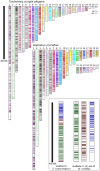Strong Signatures of Selection on Candidate Genes Underlying Core Speciation Mechanisms in Desert Tortoises
- PMID: 40129241
- PMCID: PMC12225707
- DOI: 10.1111/1755-0998.14098
Strong Signatures of Selection on Candidate Genes Underlying Core Speciation Mechanisms in Desert Tortoises
Abstract
Genomic incompatibilities and differential ecological adaptation are thought to be fundamental mechanisms of speciation. In this study, we generated a chromosome-scale reference genome and annotation for Gopherus morafkai , the Sonoran Desert tortoise, and conducted a detailed analysis of genes under positive selection with its sister species, the Mojave Desert tortoise. They occupy desert habitats with differing seasonal rainfall patterns and have considerable behavioural and reproductive differences, yet maintain a narrow hybrid zone. We find high conservation of synteny with other chelonian species. Results show extensive positive selection (422 candidate genes) relating to eye development and function that may reflect differences in UV exposure, as well as core reproductive isolation mechanisms of sperm-egg recognition, spindle assembly checkpoint and sister chromatid pairing. Together, our results offer strong genomic support and speciation genomic resources for processes shaping reproductive isolation in chelonians.
Keywords: Gopherus; postzygotic; prezygotic; reinforcement; speciation; spindle assembly checkpoint.
© 2025 The Author(s). Molecular Ecology Resources published by John Wiley & Sons Ltd.
Conflict of interest statement
The authors declare no conflicts of interest.
Figures



Similar articles
-
Divergence in Regulatory Regions and Gene Duplications May Underlie Chronobiological Adaptation in Desert Tortoises.Mol Ecol. 2025 Jan;34(2):e17600. doi: 10.1111/mec.17600. Epub 2024 Dec 3. Mol Ecol. 2025. PMID: 39624910
-
Signs and symptoms to determine if a patient presenting in primary care or hospital outpatient settings has COVID-19.Cochrane Database Syst Rev. 2022 May 20;5(5):CD013665. doi: 10.1002/14651858.CD013665.pub3. Cochrane Database Syst Rev. 2022. PMID: 35593186 Free PMC article.
-
Psychological interventions for adults who have sexually offended or are at risk of offending.Cochrane Database Syst Rev. 2012 Dec 12;12(12):CD007507. doi: 10.1002/14651858.CD007507.pub2. Cochrane Database Syst Rev. 2012. PMID: 23235646 Free PMC article.
-
Measures implemented in the school setting to contain the COVID-19 pandemic.Cochrane Database Syst Rev. 2022 Jan 17;1(1):CD015029. doi: 10.1002/14651858.CD015029. Cochrane Database Syst Rev. 2022. Update in: Cochrane Database Syst Rev. 2024 May 2;5:CD015029. doi: 10.1002/14651858.CD015029.pub2. PMID: 35037252 Free PMC article. Updated.
-
How lived experiences of illness trajectories, burdens of treatment, and social inequalities shape service user and caregiver participation in health and social care: a theory-informed qualitative evidence synthesis.Health Soc Care Deliv Res. 2025 Jun;13(24):1-120. doi: 10.3310/HGTQ8159. Health Soc Care Deliv Res. 2025. PMID: 40548558
References
-
- Adams, D. K. , and Comrie A. C.. 1997. “The North American Monsoon.” Bulletin of the American Meteorological Society 78: 2197–2213.
-
- Altschul, S. F. , Gish W., Miller W., Myers E. W., and Lipman D. J.. 1990. “Basic Local Alignment Search Tool.” Journal of Molecular Biology 215: 403–410. - PubMed
-
- Ammermüller, J. , Itzhaki A., Weiler R., and Perlman I.. 1998. “UV‐Sensitive Input to Horizontal Cells in the Turtle Retina.” European Journal of Neuroscience 10: 1544–1552. - PubMed
-
- Andrews, S. 2010. “FastQC: A Quality Control Tool for High Throughput Sequence Data.”
MeSH terms
LinkOut - more resources
Full Text Sources

